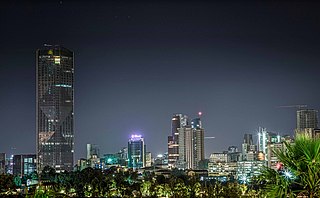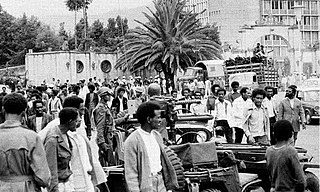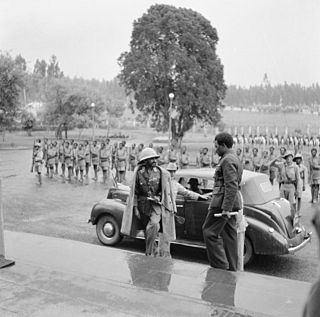
Haile Selassie I was the Emperor of Ethiopia from 1930 to 1974. He rose to power as Regent Plenipotentiary of Ethiopia (Enderase) for Empress Zewditu from 1916 until 1930. Haile Selassie is widely considered a defining figure in modern Ethiopian history, and the major figure of Rastafari, a religious movement in Jamaica that emerged shortly after he became emperor in the 1930s. Before he rose to power he defeated Ras Gugsa Welle Bitul of Begemder at the Battle of Anchem in 1928. He was a member of the Solomonic dynasty, which claims to trace lineage to Emperor Menelik I, a legendary figure believed by the claimants to be the son of King Solomon and the Queen of Sheba, who they name as Makeda.

Addis Ababa is the capital and largest city of Ethiopia. In the 2007 census, the city's population was estimated to be 2,739,551 inhabitants. Addis Ababa is a highly developed and important cultural, artistic, financial and administrative centre of Ethiopia.

Mengistu Haile Mariam is an Ethiopian former politician and former army officer who was the head of state of Ethiopia from 1977 to 1991 and General Secretary of the Workers' Party of Ethiopia from 1984 to 1991. He was the chairman of the Derg, the socialist military junta that governed Ethiopia, from 1977 to 1987, and the president of the People's Democratic Republic of Ethiopia (PDRE) from 1987 to 1991.

Addis Ababa University (AAU) is a national university located in Addis Ababa, Ethiopia. It is the oldest university in Ethiopia. AAU has thirteen campuses. Twelve of these are situated in Addis Ababa, and one is located in Bishoftu, about 45 kilometres (28 mi) away. AAU has several associated research institutions including the Institute of Ethiopian Studies. The Ministry of Education admits qualified students to AAU based on their score on the Ethiopian University Entrance Examination (EUEE).

Prince Makonnen Haile Selassie, Duke of Harar was the second son, and second-youngest child, of Emperor Haile Selassie of Ethiopia and Empress Menen Asfaw. He was made Mesfin of Harar upon the coronation of his parents in 1930.

The Ethiopian Civil War was a civil war in Ethiopia and present-day Eritrea, fought between the Ethiopian military junta known as the Derg and Ethiopian-Eritrean anti-government rebels from 12 September 1974 to 28 May 1991.

The Ethiopian Red Terror, also known as the Qey Shibir, was a violent political repression campaign of the Derg against other competing Marxist-Leninist groups in Ethiopia and present-day Eritrea from 1976 to 1978. The Qey Shibir was an attempt to consolidate Derg rule during the political instability after their overthrow of Emperor Haile Selassie in 1974 and the subsequent Ethiopian Civil War. The Qey Shibir was based on the Red Terror of the Russian Civil War, and most visibly took place after Mengistu Haile Mariam became chairman of the Derg on 3 February 1977. It is estimated that 10,000 to 980,000 people were killed over the course of the Qey Shibir.

The history of Addis Ababa, capital of Ethiopia, formally begins with the founding of the city in the 19th century by Ethiopian Emperor Menelik II and his wife Empress Taytu Betul. In its first years the city was more like a military encampment than a town. The central focus was the emperor’s palace, which was surrounded by the dwellings of his troops and of his innumerable retainers. In the 1920s, Addis Ababa experienced a significant economic upturn, marked by a surge in the number of middle-class-owned buildings, including stone houses furnished with imported European furniture. The middle class also introduced newly manufactured automobiles and expanded banking institutions. Urbanization and modernization persisted during the Italian occupation, guided by a masterplan aimed at transforming Addis Ababa into a more "colonial" city, a trajectory that continued beyond the occupation. Subsequent master plans, formulated from the 1940s onward with the input of European consultants, focused on the development of monuments, civic structures, satellite cities, and the inner city.

LijMikael Imru was an Ethiopian politician who was Prime Minister of Ethiopia from 3 August to 12 September 1974.
The following lists events that happened during 1974 in Ethiopia.

Lieutenant Colonel Asrat Desta was an Ethiopian soldier and politician who was the Chairman of Information and Public Relation Committee of the PMAC of Ethiopia. He died on 3 February 1977, together with Head of State Brigadier General Tafari Benti and five other officers in a coup d'état carried out against them by Colonel Mengistu Haile Mariam.

Maaza Mengiste is an Ethiopian-American writer. Her novels include Beneath the Lion's Gaze (2010) and The Shadow King (2019), which was shortlisted for the 2020 Booker Prize.

Meyazia 27 Square, commonly called Arat Kilo, is an important and historic intersection and surrounding neighborhood in Addis Ababa, Ethiopia, located where Adwa St, King George VI St, Queen Elizabeth II St, and Development Through Cooperation Ave come together. Its name denotes 27 Miyazya, both the day when Addis Ababa fell to Italy in 1936 and was liberated in 1941. The park is under the aegis of the Addis Ababa Land Development and Urban Renewal Agency.
The Imperial Academy was the national academy of Ethiopia, first established by the Ministry of Education and Fine Arts in 1942. It was tasked with preserving the "traditional genius" of the country; among other things, the native Ethiopic script and the literary and scholarly tradition it enabled, as well as the "promotion of research in languages and fine arts".

The monument to the Lion of Judah is a statue of the Lion of Judah, a symbol of Ethiopian Emperors and Ethiopia, and is located in Addis Ababa.
Alem Bekagn, or 'Kerchele Prison', was a central prison in Ethiopia until 2004. Located in Addis Ababa, the prison possibly existed as early as 1923, under the reign of Empress Zewditu, but became notorious after Second Italo-Ethiopian War as the site where Ethiopian intellectuals were detained and killed by Italian Fascists in the Yekatit 12 massacre. After the restoration of Emperor Haile Selassie, the prison remained in use to house Eritrean nationalists and those involved in the Woyane rebellion. Under the Communist Derg regime that followed, the prison was the site of another mass killing, the Massacre of the Sixty, and of the torture and execution of rival groups in the Red Terror. The prison remained a site of human rights abuses until the Ethiopian People’s Revolutionary Democratic Front entered Addis Ababa on 28 May 1991, after which it became a normal prison. The prison was closed in 2004 and demolished in 2007 to allow the construction of the headquarters of the African Union.

On 12 September 1974, Emperor Haile Selassie was deposed by the Coordinating Committee of the Armed Forces, Police, and Territorial Army, a Soviet-backed military junta that consequently ruled Ethiopia as the Derg until 28 May 1991.
This is chronology of the Ethiopian Revolution that took place from 12 January to 12 September 1974 in the Ethiopian Empire.

On 17 February 1992, the Ethiopian Radio announced the discovery of burial of the Ethiopian Emperor Haile Selassie beneath his office in National Palace by workmen. The discovery happened nearly one year after the former military government Derg collapse in 1991, and under the interim government led by the Ethiopian People's Revolutionary Democratic Front (EPRDF).















